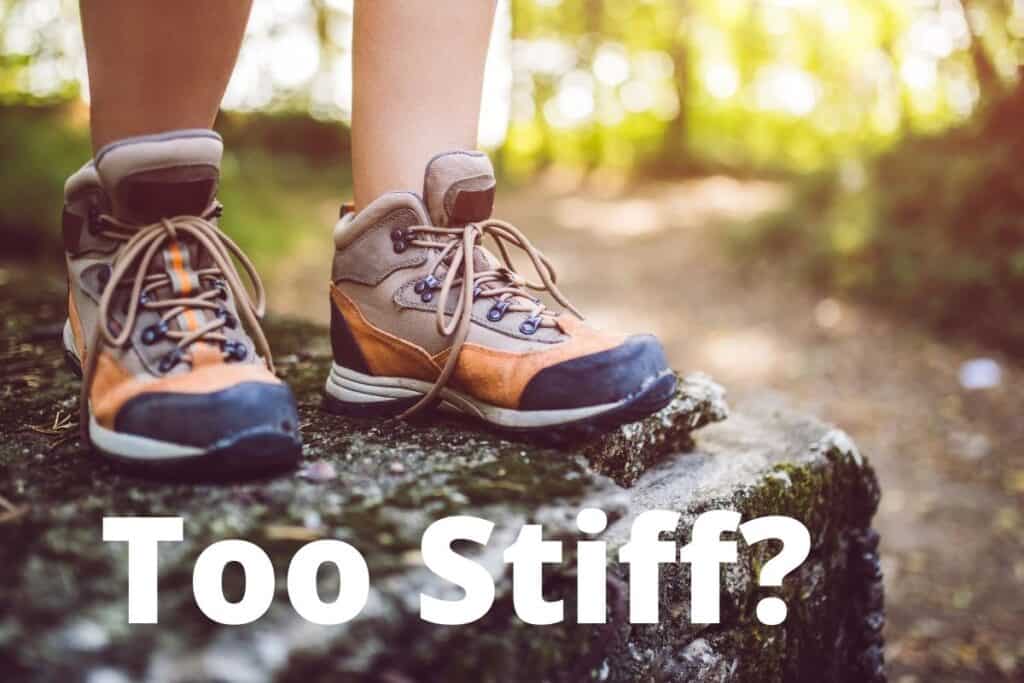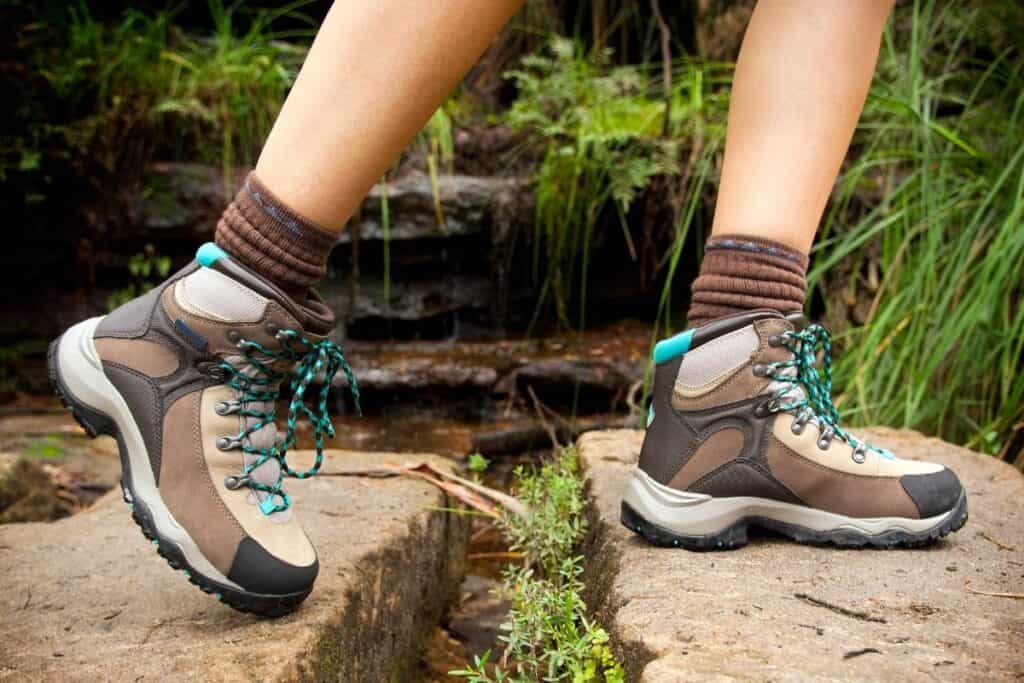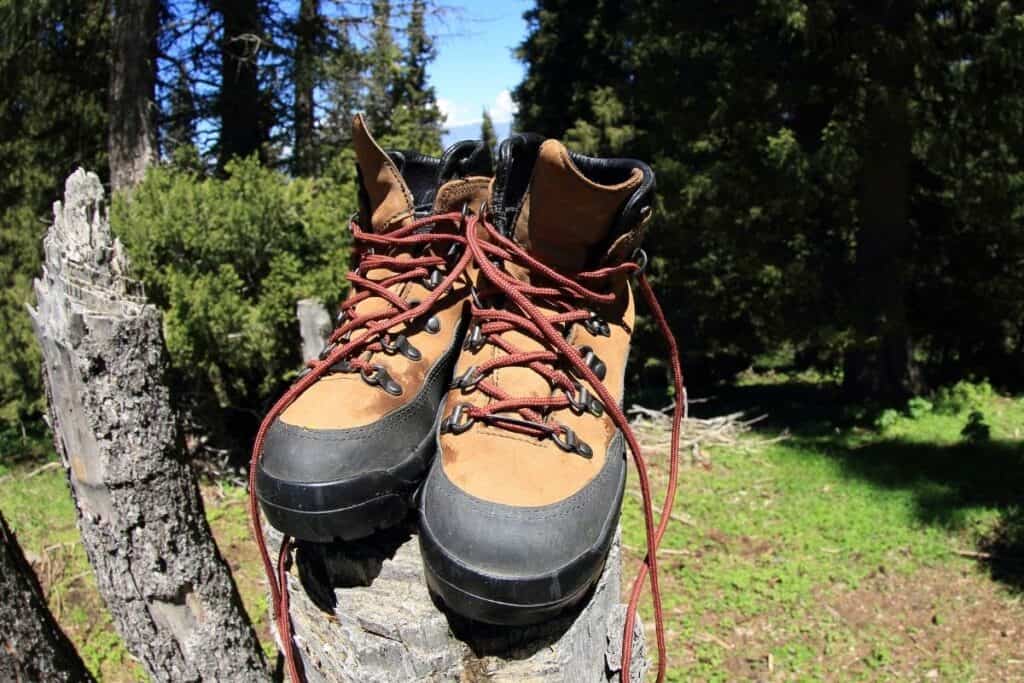
If you’re like most hikers, your hiking boots are probably pretty stiff. But have you ever wondered why they are so stiff?
In this blog post, we’ll take a look at the reasons why hiking boots are so stiff and some of the benefits of having them that way. So if you’re curious about why hiking boots are so stiff, read on!
4 Reasons Why Hiking Boots Are Stiff
There are quite a few reasons why hiking boots are so stiff. Below are some of them.
1. Durability
One of the biggest is durability. If your boots aren’t stiff enough, they won’t protect your feet from the elements or keep them safe on rocky trails.
And if they are not durable, they will get wet and won’t dry out quickly because the insides are soaked with water and sweat (and will smell horrible if not dried), and they’ll be heavy to carry on your hike.
2. Stability
Another reason for hiking boots being stiff is stability. Even when walking on moderate terrain, you need your feet to be stable.
Stiff boots make sure you won’t roll your ankles, which is essential because moving them can result in sprained ankles.
And also, more rigid boots are generally more stable than more flexible ones, so you can wear them on rocky trails without worrying about wearing out their outsoles quickly.
3. Comfort
Stiffness also provides comfort. Without it, your feet will move up and down with each step you take, which can cause blisters, abrasions, and even impact injuries. Blisters are common in (new) hiking boots.
They usually form when boots aren’t worn in, or the boot is too tight around the foot. An excellent way to avoid blisters is to lace your shoes properly and wear them in before going on a hike.
4. Support
Stiff hiking boots also support your feet, especially when you’re walking down a steep trail or climbing up a hill.
They keep your ankles from rolling and prevent you from slipping, which is pretty standard if the trail is wet!
Support is essential for your hiking boots’ outsoles as they help you keep your footing on a steep trail.

How Stiff Should Hiking Boots Be?
Hiking boots should be as stiff as the terrain you’re hiking on. For example, if you hike primarily on flat ground, a flexible boot should be fine. It will provide stability but won’t restrict your ankle movement as much as a stiffer one would.
If you hike mostly on uneven trails, where there are lots of rocks and roots to step on, then you should get stiffer boots. When you’re walking on steep sections of the trail, more rigid boots will provide more support for your ankles than flexible ones.
If you want to hike in really rough terrain with large rocks and boulders to climb over or crawl under, you’ll need highly sturdy shoes or boots. So, for trails like that, you’ll want a boot that is as rigid as a rock!
If you hike on different types of terrain, then you should get boots that are appropriate for each type. For example, if you also hike on flat ground from time to time and prefer hiking shoes to stiff hiking boots, make sure your shoes are flexible enough to be worn on rocky trails.
That way, you’ll get all the benefits of hiking with either boot without having to buy two different pairs of shoes or boots.

Drawbacks to Stiff Hiking Boots
As explained below, there are also downsides to hiking boots being so stiff.
1. Causes Injuries
The first is that they can cause impact injuries, especially to your heels or ankles – although this is only likely if the boot is too rigid for you.
They can also cause nerve damage in your legs. This is more likely if they’re too stiff or you wear them for a long time without taking a break.
2. Causes Blisters
Long hikes in stiff boots can cause blisters because they don’t allow your feet to breathe and get sweaty quickly.
If the boots are waterproof, your feet might absorb all the moisture and start smelling. This is especially common in hiking boots worn by people who don’t let their feet rest after a long hike.
3. Causes Loss of Toe Motor Skills
Stiff boots can also cause you to lose control over your foot muscles because they make it harder to feel the ground when you take each step, which has health benefits (gait training, balance training).
Wearing stiff boots for a long time can cause your feet to lose muscle tone and lead to weaker muscles over time.
4. Stiff Boots Make Your Legs Weaker
Wearing them for an extended period also slows down the development of your knee and leg muscles.
Also, hiking boots with little cushioning make your quads and other leg muscles weaker and less flexible than they should be.
This also increases your chance of injury because you’re not used to putting so much stress on your legs.
5. Causes Cuts and Abrasions
Another drawback of stiff boots is that they can scratch or cut your shins because your feet might rub against them as you like.
This isn’t likely to happen on a well-fit boot, but it’s still possible if the boot is too big or rigid.
6. Take Longer to Break In
The other problem with very stiff shoes and boots is that they will take longer to break in than softer ones, which means more time on rocky trails when your feet are very sore.
Breaking in boots is not only painful; it’s also time-consuming!
7. Causes Pain in Your Knees
Wearing stiff boots for a long time can also cause knee and back pain because they don’t allow you to bend and step naturally.
This will only happen if the boot is too rigid for your needs. Also, wearing them without proper socks can cause chafing and blisters, which nobody wants.
How to Make Stiff Hiking Boots More Comfortable
To make your hiking boots more comfortable, you can do a couple of things!
#1 Break Them In!
You should break your hiking boots in before your first hike if you want to make them more comfortable.
You can do this by wearing them around the house and even while doing light exercises like walking on a treadmill – if possible.
If you can’t break them in before your hike, then at least take a break every hour or so while you’re on the trail.
#2 Wear Moleskin or Other Layers to Prevent Blisters and Chafing
You should also consider wearing moleskin or other protective layers between your feet and the boots if they tend to rub against your feet or ankles, which can cause blisters and chafing.
You can also wear socks with extra cushioning to reduce friction between your feet and the boots.
#3 Use Moleskin on Other Areas of Your Feet
If you’re wearing hiking boots with little ventilation, then you might want to use moleskin to cover hot spots between your toes to prevent chafing.
Be sure not to use it over areas already bleeding or too raw. You should also wear two pairs of socks if you have thin socks because they will be more comfortable than one thin pair of socks.
#4 Wear Stiff Boots More Often
The best solution for stiff boots is to wear them more often. The more you wear them, the more comfortable they will become.
Also, you can use them for other purposes so that your feet don’t have to do all the work – like jogging or riding a bike.
Whether stiff boots are good or bad depends on the type of hiking you plan to do.
If your hikes will be long and challenging, then it’s better to get boots that are soft enough so that they don’t cause problems like loss of toe motor skills, muscle weakness, cuts and abrasions, muscle control, knee pain, leg pain, back pain, blisters, chafing, and other problems.
But if your hikes are short or not too challenging, then you can use boots that are less flexible to protect your feet from rocks and water.
